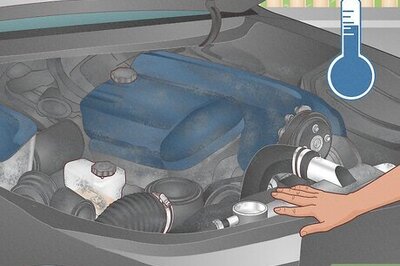
views
F
=
m
a
.
{\displaystyle \mathbf {F} =m\mathbf {a} .}
The work done by the force will become converted into increased kinetic energy in the body. We derive the expression for kinetic energy from these basic principles.
Derivation Using Calculus
Begin with the Work-Energy Theorem. The work that is done on an object is related to the change in its kinetic energy. Δ K = W {\displaystyle \Delta K=W} \Delta K=W
Rewrite work as an integral. The end goal is to rewrite the integral in terms of a velocity differential. Δ K = ∫ F ⋅ d r {\displaystyle \Delta K=\int \mathbf {F} \cdot \mathrm {d} \mathbf {r} } \Delta K=\int {\mathbf {F}}\cdot {\mathrm {d}}{\mathbf {r}}
Rewrite force in terms of velocity. Note that mass is a scalar and can therefore be factored out. Δ K = ∫ m a ⋅ d r = m ∫ d v d t ⋅ d r {\displaystyle {\begin{aligned}\Delta K&=\int m\mathbf {a} \cdot \mathrm {d} \mathbf {r} \\&=m\int {\frac {\mathrm {d} \mathbf {v} }{\mathrm {d} t}}\cdot \mathrm {d} \mathbf {r} \end{aligned}}} {\begin{aligned}\Delta K&=\int m{\mathbf {a}}\cdot {\mathrm {d}}{\mathbf {r}}\\&=m\int {\frac {{\mathrm {d}}{\mathbf {v}}}{{\mathrm {d}}t}}\cdot {\mathrm {d}}{\mathbf {r}}\end{aligned}}
Rewrite the integral in terms of a velocity differential. Here, it is trivial, because dot products commute. Recall the definition of velocity as well. Δ K = m ∫ d r d t ⋅ d v = m ∫ v ⋅ d v {\displaystyle {\begin{aligned}\Delta K&=m\int {\frac {\mathrm {d} \mathbf {r} }{\mathrm {d} t}}\cdot \mathrm {d} \mathbf {v} \\&=m\int \mathbf {v} \cdot \mathrm {d} \mathbf {v} \end{aligned}}} {\begin{aligned}\Delta K&=m\int {\frac {{\mathrm {d}}{\mathbf {r}}}{{\mathrm {d}}t}}\cdot {\mathrm {d}}{\mathbf {v}}\\&=m\int {\mathbf {v}}\cdot {\mathrm {d}}{\mathbf {v}}\end{aligned}}
Integrate over change in velocity. Typically, initial velocity v 0 {\displaystyle v_{0}} v_{{0}} is set to 0. Δ K = 1 2 m v 2 − 1 2 m v 0 2 = 1 2 m v 2 {\displaystyle {\begin{aligned}\Delta K&={\frac {1}{2}}mv^{2}-{\frac {1}{2}}mv_{0}^{2}\\&={\frac {1}{2}}mv^{2}\end{aligned}}} {\begin{aligned}\Delta K&={\frac {1}{2}}mv^{{2}}-{\frac {1}{2}}mv_{{0}}^{{2}}\\&={\frac {1}{2}}mv^{{2}}\end{aligned}}
Derivation Using Algebra
Begin with the Work-Energy Theorem. The work that is done on an object is related to the change in its kinetic energy. Δ K = W {\displaystyle \Delta K=W} \Delta K=W
Rewrite work in terms of acceleration. Note that using algebra alone in this derivation restricts us to constant acceleration. Δ K = F Δ x = m a Δ x {\displaystyle {\begin{aligned}\Delta K&=F\Delta x\\&=ma\Delta x\end{aligned}}} {\begin{aligned}\Delta K&=F\Delta x\\&=ma\Delta x\end{aligned}} Here, Δ x {\displaystyle \Delta x} \Delta x is the displacement.
Relate velocity, acceleration, and displacement. There are several constant acceleration kinematic equations that relate time, displacement, velocity, and acceleration. The "timeless" equation which does not contain time is below. v 2 = v 0 2 + 2 a Δ x {\displaystyle v^{2}=v_{0}^{2}+2a\Delta x} v^{{2}}=v_{{0}}^{{2}}+2a\Delta x When an object starts from rest, v 0 = 0. {\displaystyle v_{0}=0.} v_{{0}}=0.
Solve for acceleration. Remember, initial velocity is 0. a = v 2 2 Δ x {\displaystyle a={\frac {v^{2}}{2\Delta x}}} a={\frac {v^{{2}}}{2\Delta x}}
Substitute acceleration into the original equation and simplify. Δ K = m ( v 2 2 Δ x ) Δ x = 1 2 m v 2 {\displaystyle {\begin{aligned}\Delta K&=m\left({\frac {v^{2}}{2\Delta x}}\right)\Delta x\\&={\frac {1}{2}}mv^{2}\end{aligned}}} {\begin{aligned}\Delta K&=m\left({\frac {v^{{2}}}{2\Delta x}}\right)\Delta x\\&={\frac {1}{2}}mv^{{2}}\end{aligned}}


















Comments
0 comment